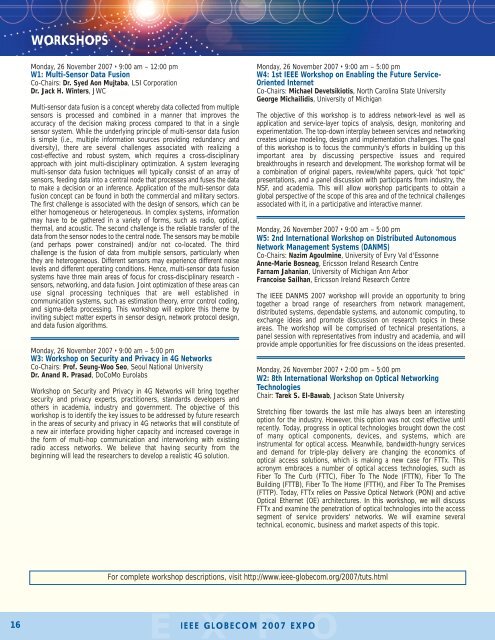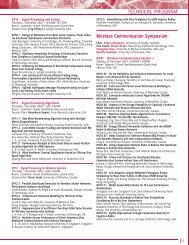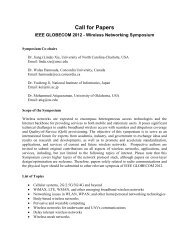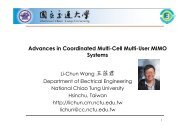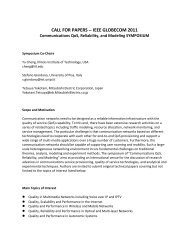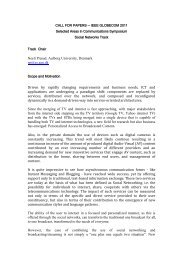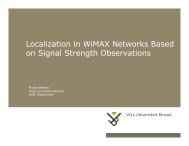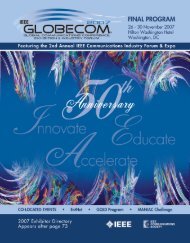information - IEEE GLOBECOM 2013
information - IEEE GLOBECOM 2013
information - IEEE GLOBECOM 2013
Create successful ePaper yourself
Turn your PDF publications into a flip-book with our unique Google optimized e-Paper software.
WORKSHOPS<br />
Monday, 26 November 2007 • 9:00 am – 12:00 pm<br />
W1: Multi-Sensor Data Fusion<br />
Co-Chairs: Dr. Syed Aon Mujtaba, LSI Corporation<br />
Dr. Jack H. Winters, JWC<br />
Multi-sensor data fusion is a concept whereby data collected from multiple<br />
sensors is processed and combined in a manner that improves the<br />
accuracy of the decision making process compared to that in a single<br />
sensor system. While the underlying principle of multi-sensor data fusion<br />
is simple (i.e., multiple <strong>information</strong> sources providing redundancy and<br />
diversity), there are several challenges associated with realizing a<br />
cost-effective and robust system, which requires a cross-disciplinary<br />
approach with joint multi-disciplinary optimization. A system leveraging<br />
multi-sensor data fusion techniques will typically consist of an array of<br />
sensors, feeding data into a central node that processes and fuses the data<br />
to make a decision or an inference. Application of the multi-sensor data<br />
fusion concept can be found in both the commercial and military sectors.<br />
The first challenge is associated with the design of sensors, which can be<br />
either homogeneous or heterogeneous. In complex systems, <strong>information</strong><br />
may have to be gathered in a variety of forms, such as radio, optical,<br />
thermal, and acoustic. The second challenge is the reliable transfer of the<br />
data from the sensor nodes to the central node. The sensors may be mobile<br />
(and perhaps power constrained) and/or not co-located. The third<br />
challenge is the fusion of data from multiple sensors, particularly when<br />
they are heterogeneous. Different sensors may experience different noise<br />
levels and different operating conditions. Hence, multi-sensor data fusion<br />
systems have three main areas of focus for cross-disciplinary research -<br />
sensors, networking, and data fusion. Joint optimization of these areas can<br />
use signal processing techniques that are well established in<br />
communication systems, such as estimation theory, error control coding,<br />
and sigma-delta processing. This workshop will explore this theme by<br />
inviting subject matter experts in sensor design, network protocol design,<br />
and data fusion algorithms.<br />
Monday, 26 November 2007 • 9:00 am – 5:00 pm<br />
W3: Workshop on Security and Privacy in 4G Networks<br />
Co-Chairs: Prof. Seung-Woo Seo, Seoul National University<br />
Dr. Anand R. Prasad, DoCoMo Eurolabs<br />
Workshop on Security and Privacy in 4G Networks will bring together<br />
security and privacy experts, practitioners, standards developers and<br />
others in academia, industry and government. The objective of this<br />
workshop is to identify the key issues to be addressed by future research<br />
in the areas of security and privacy in 4G networks that will constitute of<br />
a new air interface providing higher capacity and increased coverage in<br />
the form of multi-hop communication and interworking with existing<br />
radio access networks. We believe that having security from the<br />
beginning will lead the researchers to develop a realistic 4G solution.<br />
Monday, 26 November 2007 • 9:00 am – 5:00 pm<br />
W4: 1st <strong>IEEE</strong> Workshop on Enabling the Future Service-<br />
Oriented Internet<br />
Co-Chairs: Michael Devetsikiotis, North Carolina State University<br />
George Michailidis, University of Michigan<br />
The objective of this workshop is to address network-level as well as<br />
application and service-layer topics of analysis, design, monitoring and<br />
experimentation. The top-down interplay between services and networking<br />
creates unique modeling, design and implementation challenges. The goal<br />
of this workshop is to focus the community's efforts in building up this<br />
important area by discussing perspective issues and required<br />
breakthroughs in research and development. The workshop format will be<br />
a combination of original papers, review/white papers, quick "hot topic"<br />
presentations, and a panel discussion with participants from industry, the<br />
NSF, and academia. This will allow workshop participants to obtain a<br />
global perspective of the scope of this area and of the technical challenges<br />
associated with it, in a participative and interactive manner.<br />
Monday, 26 November 2007 • 9:00 am – 5:00 pm<br />
W5: 2nd International Workshop on Distributed Autonomous<br />
Network Management Systems (DANMS)<br />
Co-Chairs: Nazim Agoulmine, University of Evry Val d'Essonne<br />
Anne-Marie Bosneag, Ericsson Ireland Research Centre<br />
Farnam Jahanian, University of Michigan Ann Arbor<br />
Francoise Sailhan, Ericsson Ireland Research Centre<br />
The <strong>IEEE</strong> DANMS 2007 workshop will provide an opportunity to bring<br />
together a broad range of researchers from network management,<br />
distributed systems, dependable systems, and autonomic computing, to<br />
exchange ideas and promote discussion on research topics in these<br />
areas. The workshop will be comprised of technical presentations, a<br />
panel session with representatives from industry and academia, and will<br />
provide ample opportunities for free discussions on the ideas presented.<br />
Monday, 26 November 2007 • 2:00 pm – 5:00 pm<br />
W2: 8th International Workshop on Optical Networking<br />
Technologies<br />
Chair: Tarek S. El-Bawab, Jackson State University<br />
Stretching fiber towards the last mile has always been an interesting<br />
option for the industry. However, this option was not cost effective until<br />
recently. Today, progress in optical technologies brought down the cost<br />
of many optical components, devices, and systems, which are<br />
instrumental for optical access. Meanwhile, bandwidth-hungry services<br />
and demand for triple-play delivery are changing the economics of<br />
optical access solutions, which is making a new case for FTTx. This<br />
acronym embraces a number of optical access technologies, such as<br />
Fiber To The Curb (FTTC), Fiber To The Node (FTTN), Fiber To The<br />
Building (FTTB), Fiber To The Home (FTTH), and Fiber To The Premises<br />
(FTTP). Today, FTTx relies on Passive Optical Network (PON) and active<br />
Optical Ethernet (OE) architectures. In this workshop, we will discuss<br />
FTTx and examine the penetration of optical technologies into the access<br />
segment of service providers' networks. We will examine several<br />
technical, economic, business and market aspects of this topic.<br />
For complete workshop descriptions, visit http://www.ieee-globecom.org/2007/tuts.html<br />
16<br />
E X P O<br />
<strong>IEEE</strong> <strong>GLOBECOM</strong> 2007 EXPO


